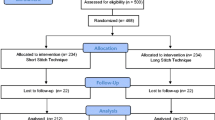Abstract
Background
Internal hernias occur frequently after laparoscopic gastric bypass. We have found no data on the relative strength of the various techniques available for closing these defects. The present study was performed to obtain such data to form a theoretical basis for clinical studies.
Methods
Six piglets were operated laparoscopically and four loops of small bowel created in each. These mesenteric gaps were closed over a distance of 40 mm using (1) running 2–0 Ethibond® suture, (2) Endo Hernia stapler, (3) fibrin glue (Tisseel®) and (4) controls, where the mesenteric surfaces were rubbed with a sponge and approximated without further intervention. After 6 weeks, the different segments of the mesentery were excised. The tensile strength was measured using continuously increased traction until the closure ruptured. The ordinary mesentery served as the control. The breaking tension and total amount of energy transferred to the tissue were registered.
Results
Control areas with rubbed areas developed no adhesions. Suture and staple lines contracted by 30 % in length, whereas the fibrin glued lines were even shorter. Median tensile strength was greatest for the sutured lines (14,293 mN) and stapled lines (10,798 mN). Fibrin glued lines were significantly weaker (6,780 mN, p = 0.013 and p = 0.026), but as strong as ordinary mesentery (4,165 mN).
Conclusions
If ongoing controlled randomized trials show closure to be beneficial, further studies should include staples as one of the options for the closure of mesenteric defects. The role of fibrin glue needs to be further investigated.





Similar content being viewed by others
References
Champion JK, Williams M. Small bowel obstruction and internal hernias after laparoscopic Roux en-Y gastric bypass. Obes Surg. 2003;13:596–600.
Cho M, Pinto D, Carrodeguas L, et al. Frequency and management of internal hernias after laparoscopic antecolic antegastric Roux-en-Y gastric bypass without division of the small bowel mesentery or closure of mesenteric defects: review of 1400 consecutive cases. Surg Obes Relat Dis. 2006;2:87–91.
Comeau E, Gagner M, Inabnet WB, et al. Symptomatic internal hernias after laparoscopic bariatric surgery. Surg Endosc. 2005;19:34–9.
Higa KD, Ho T, Boone KB. Internal hernias after laparoscopic Roux-en-Y gastric bypass: incidence, treatment and prevention. Obes Surg. 2003;13:350–4.
Iannelli A, Buratti MS, Novellas S, et al. Internal hernia as a complication of laparoscopic Roux-en-Y gastric bypass. Obes Surg. 2007;17:1283–6.
Steele KE, Prokopowicz GP, Magnuson T, et al. Laparoscopic antecolic Roux-en-Y gastric bypass with closure of internal defects leads to fewer internal hernias than the retrocolic approach. Surg Endosc. 2008;22:2056–61.
Aghajani E, Jacobsen HJ, Nergaard BJ, Hedenbro JL, Leifson BG, Gislason H. Internal Hernia after gastric bypass: a new and simplified technique for laparoscopic primary closure of the mesenteric defects. J Gastroint Surg. 2012;16(3):641–5.
Cruz-Munoz N, Cabrera JC, Cuesta M, et al. Closure of mesenteric defect can lead to decrease in internal hernias after Roux-en-Y gastric bypass. Surg Obes Relat Dis. 2011;7:176–80.
Paroz A, Calmes JM, Giusti V, et al. Internal hernia after laparoscopic Roux-en-Y gastric bypass for morbid obesity: a continuous challenge in bariatric surgery. Obes Surg. 2006;16:1482–7.
Silecchia G, Boru CE, Mouiel J, et al. The use of fibrin sealant to prevent major complications following laparoscopic gastric bypass: results of a multicenter, randomized trial. Surg Endosc. 2008;22:2492–7.
Colquitt JL, Picot J, Loveman E. et al. Surgery for obesity. Cochrane Database Syst Rev. 2009; CD003641.
Sjostrom L, Narbro K, Sjostrom CD, et al. Effects of bariatric surgery on mortality in Swedish obese subjects. N Engl J Med. 2007;357:741–52.
Buchwald H, Oien DM. Metabolic/bariatric surgery worldwide 2008. Obes Surg. 2009;19:1605–11.
Carmody B, DeMaria EJ, Jamal M, et al. Internal hernia after laparoscopic Roux-en-Y gastric bypass. Surg Obes Relat Dis. 2005;1:543–8.
Rodriguez A, Mosti M, Sierra M, et al. Small bowel obstruction after antecolic and antegastric laparoscopic Roux-en-Y gastric bypass: could the incidence be reduced? Obes Surg. 2010;20:1380–4.
Tingstedt B, Isaksson K, Andersson E, et al. Prevention of abdominal adhesions—present state and what’s beyond the horizon? Eur Surg Res. 2007;39:259–68.
Murakami M, Tono T, Okada K, et al. Fibrin glue injection method with diluted thrombin for refractory postoperative digestive fistula. Am J Surg. 2009;198:715–9.
Conflicts of Interest and Source of Funding
None.
Author information
Authors and Affiliations
Corresponding author
Rights and permissions
About this article
Cite this article
Jacobsen, H., Dalenbäck, J., Ekelund, M. et al. Tensile Strength After Closure of Mesenteric Gaps in Laparoscopic Gastric Bypass: Three Techniques Tested in a Porcine Model. OBES SURG 23, 320–324 (2013). https://doi.org/10.1007/s11695-012-0800-3
Published:
Issue Date:
DOI: https://doi.org/10.1007/s11695-012-0800-3




